Natural Products Expo West – Photo Gallery
Thought it might be fun to take a look at some of the cool exhibits, enthusiastic people and tasty products from Natural Products Expo West:
Thought it might be fun to take a look at some of the cool exhibits, enthusiastic people and tasty products from Natural Products Expo West:
What are your tradeshow marketing goals? It may seem an obvious question. But it bears some attention before schlepping off to the show, setting up and accosting attendees.
Each show is different with a unique audience and a unique set of competitors. How you determine your goals depends on those combinations. Some shows may be better at connecting you with retailers, some better at interacting with buyers, others better at connecting with bigwigs who can make big things happen.
In general, the tradeshow marketing goals can fall under three main areas:
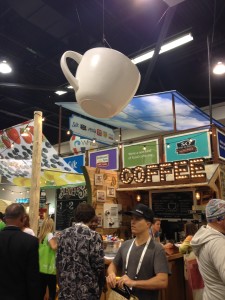
Brand Awareness and Perception
In this area, you can build on your company’s marketplace awareness with an effectively branded booth that shows off your credentials or capabilities. You can promote specific products, launch new products, position your company effectively against competitors, or even reach new markets.
This is where you can work to increase traffic, have one of your managers speak at a conference or panel, speak with industry media outlets, compile information about your competitors, interact with attendees, promote your message, give demos or hand out samples, work to build traffic through promotions and social media engagement and more.
I’ve always advocated that exhibitors count visitors. It’s not always easy on the crazy chaos of a tradeshow floor, but if you can keep count you’ll know the number of visitors you had. Use that as a baseline and count the visitors at each show and compare year-to-year. You’ll also count leads and sales that result from those leads. Do a little market research by taking a survey or visitors and compile the results. Keep count of any new distributors, suppliers, retail buyers and more.
Knowing your tradeshow marketing goals gives you focus, especially since those goals change from show to show, from audience to audience.
Free Report: “7 Questions You’ll Never Ask Your Exhibit House”
There are hundreds of styles and types of exhibits at tradeshows, but in my estimation you can reduce them to just a handful of ‘kinds’ of exhibits. Do you recognize these?

Large Format Well-Branded Exhibit. Most likely an island, but you can tell in an instant who the exhibitor is. Highly professional. The staff is smiling, greeting everyone appropriately. Kicking ass and taking names.
Next time you walk the show floor, see how many of each kind of exhibits you can identify! And if you can add to our list, feel free to drop a comment!
Time for another list – this one is called 7 tradeshow exhibit “must-haves” and it’s pretty simple. What 7 things (items, people, plans) are essential to making your next tradeshow appearance a whopping success? Let’s count them:

t kind of company you are. A good 3D exhibit designer working with a knowledgeable and responsive marketing team can work magic with the right design.
Free Report: “7 Questions You’ll Never Ask Your Exhibit House”
More than two-thirds of exhibitors do not have a solid plan in place and end up making mistakes at the tradeshow as they exhibit.
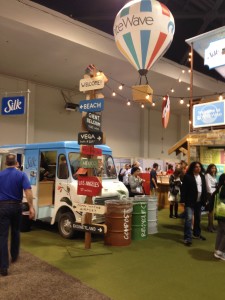
In fact, not having an organized, comprehensive plan is one of the most common mistakes that exhibitors make.
And it’s safe to say that nearly all exhibitors don’t have a solid grasp of the metrics of their success or failure that comes from that tradeshow appearance. Why? Because companies tend to put all of their energy, time and money into putting on a good show, and very little into counting the results after the end of the show. Measuring your results – leads, sales closed – is one of the most critical measurements you can make.
Let’s look at some of the common mistakes you might make as you exhibit at the tradeshow.
We all make mistakes – it’s part of life – but the more you can minimize mistakes with oodles of tradeshow marketing dollars on the table, the better off you’ll be.
Hey, it’s time to do another wrap up of tradeshow exhibit design and promotion ideas. Let’s take a swing around the internet, shall we?
First, we stop at FitSmallBusiness.com for a look at over two dozen design and promotion ideas. One idea I really like is to walk the show floor prior to the doors opening to the public and introducing yourself and inviting other exhibitors to come by your booth for a freebie.

From the Tradeshow Advisor comes a look at how to use all the display elements at your disposal to attract eyeballs. Using lighting, motion, sound and smell, you can get attendees senses involved.
Pinnacle Displays offers the 10 commandments for designing effective tradeshow graphics.
Northwest Creative Imaging posted a great infographic that details the best practices for tradeshow booth design. It’s a good one.
Our old friends at Handshake.com offer several booth design ideas to help you stand out at tradeshows.
And finally, let’s swing by Envision Creative Group for 5 Elements of an Awesome Booth Design.
All in all, some good company to keep and excellent ideas to ponder and incorporate!
Here are six random but unforgettable tradeshow tips to take you to a successful tradeshow experience.
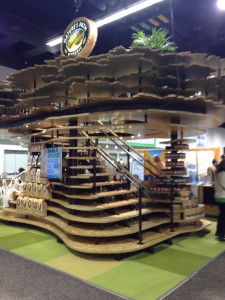
gh business cards? It happens. In fact, it happened to me last week! Plan ahead and don’t forget to take more than you think you’ll need.
Take these 6 unforgettable tradeshow tips and use them to make your next tradeshow appearance a successful one!
It may be obvious, but tradeshows bring buyers to your booth. Often, as exhibitors, we’re so focused on presenting a cohesive message, making sure our staffers are on top of things, keeping the booth clean, greeting visitors and answering questions that when someone is ready to buy we miss a beat!
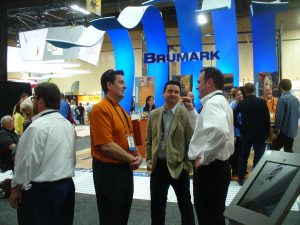
In some tradeshows you’re looking for distributors, in some you’re looking for customers, in some you’re looking to solidify and strengthen relationships with existing customers, distributors and clients. But at the bottom line, you’re at a tradeshow to connect with more buyers. More people who will say YES and open their wallet to your products and services.
By keeping this YES top of mind during the show, your staffers will be more prepared when the question does arise. Certainly not everyone in your booth is a buyer, but buying decisions and referrals are made at tradeshows. THAT’S WHY THE ATTENDEES ARE THERE: TRADESHOWS BRING BUYERS. They’re there to check out new products, new services, new releases, new iterations of current products and so on. If they’re at the show, there’s a real chance they may either eventually BUY from you or know someone who will.
Exhibit Surveys Inc’s Trade Show Trends Report from a couple of years ago shows that 49% of tradeshow attendees come to a show with the intent to purchase. Yes, that’s why they’re there – to BUY, and hopefully from you.
Are you doing all you can to facilitate the buying activity?
I love webinars.
No wait, I hate webinars.
I’ve attended so many webinars over the years that it’s easy to come away with both feelings: love and hate. Hate when you spend an hour only to have the presenter take the first 20 minutes giving you his poor sob story, 14 minutes of actual information that you can use, and 26 minutes trying to sell you on his $2,000 product.
But then there are those that cut to the chase, make it worth your while by delivering the goods. So I thought it might be fun to cruise YouTube and try to track down a handful of tradeshow webinars that are actually worth your time.
To begin, Ruth Stevens teams up with Lands’ End in 2013 for a tradeshow webinar called “Get More Out of Your Tradeshow Marketing,” which last about a half hour and is packed full of great information presented professionally.
Udi Ledorgor, author of the Amazon #1 Bestseller “The 50 Secrets of Tradeshow Success,” joined Pepperi for a fun-and-info-filled webinar. It clocks in at just under 40 minutes, so if you’re keeping score and home you now have almost 70 minutes of education to soak up by staying on this page. And if you do, of course, Google will love you, I’ll love you, and more people will find me. So you’re watching these now for TWO reasons: you’re going to learn something that will make you better at tradeshow execution and for the good of all mankind.
But wait, there’s more!
I ran across a rather long, but worthwhile webinar called “5 Tips to Maximize Your Tradeshow Experience” put on in advance of a show in 2016 called QuickBooks Connect by Kelly Bistriceanu of TSheets and Yoseph West of Hubdoc. While there are a number of QBConnect-only mentions for meetups and so forth, these two speak very knowledgeably and discuss some good ideas on planning and execution of tradeshows during this hour-plus webinar:
Okay, if you managed to make it through these webinars, I’ve taken up a couple of hours of your time by now. But y’know what? You’re smarter! And you’ve earned a break and probably a cup of coffee.
There are three phases to getting people to talk about your tradeshow exhibit. First, you’d love to get them talking about it before the show. Second, you want them talking about the exhibit during the show. And finally, you want to make it memorable enough so that they’re talking about it after the show.
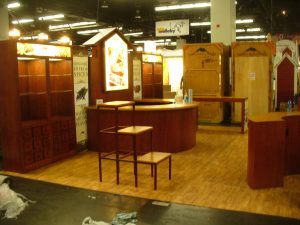
Realistically, I suppose it’s hard to achieve all of those bits and pieces with every exhibit and every show, but as my old football coach used to say, “It don’t hurt to try, do it?”
Prior to the show, set some goals. Figure out what you’d like to accomplish at the show in terms of booth traffic, leads generated and sales generated. Having these numbers in hand will help you focus. Drive traffic to your booth starting a week or so prior to the show by teasing products or in-person appearances in your booth on Facebook, Instagram, Twitter and LinkedIn, making sure you use the standard show hashtag. If you do a pre-show mailing, you can increase your booth traffic by increasing a promotional product in that mailing.
During the show, the best way to get people to talk about your exhibit is to have all hands on deck. Your staff should be well-trained and well-prepared for the show. They should be dressed appropriately (uniforms, matching tees?). The electronics in the booth should be tested and working properly, graphics should be attractive and functional. On social media, send out time-sensitive tweets and posts that invite people to see something new or meet somebody, or interact with something in the booth that appeals to the five senses. If you can pull off a few of these ideas in a clever and memorable way, show attendees will go out of their way to mention your booth.
After the show, follow up with all leads generated in a timely manner. Post photos of your exhibit and visitors over the next few weeks on social media. Mention any press you many have gotten online or in a newsletter. If you’ve created a list of email addresses or phone numbers of booth visitors, reach back to them to ask their opinion.
Word of mouth is an effective way to market your business. And even though you’re at a tradeshow, getting people to talk about your exhibit and presence at the show can start prior to the show and linger afterwards!